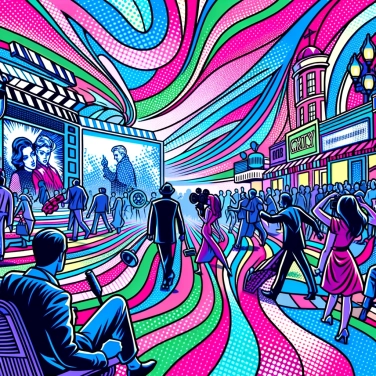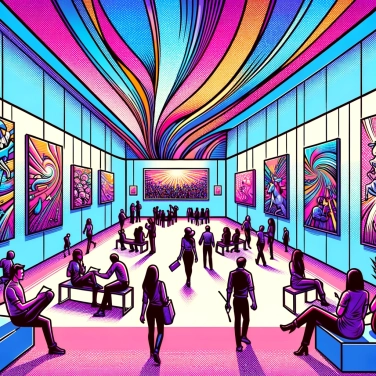Black and white films have a timeless charm for cinephiles due to their unique aesthetics, emphasis on the performances of the actors and the story, as well as the nostalgia they evoke for a bygone era.

The choice of monochrome in black and white films creates a unique aesthetic that transforms each scene into a true living painting. Without colors to distract you, you are naturally drawn to the texture, the strong contrasts of shadow and light, and the visual composition. Mundane details suddenly gain depth, like the smoke of a cigarette, the reflection of wet cobblestones, or the elongated shadows under a streetlamp at midnight. And then, by removing color, filmmakers can more easily play with symbols: a dark door evokes mystery or danger, a white dress represents purity or vulnerability. Each scene becomes more evocative, more poetic, with chiaroscuro contrasts worthy of beautiful artistic photography.
With black and white, the actor cannot hide behind flashy sets or a plethora of visual effects. The result: everything relies on facial expressions, nuances of gaze, and the power of gestures. This style, stripped down and honest, pushes the performances of actors to the limit. Their emotions literally burst from the screen, capturing attention more intensely, as there are no colors to distract the eye. Only contrasts, shadow and light play where every subtlety seems amplified, intense, almost palpable. This is also why certain performances, like those of Charlie Chaplin, Ingrid Bergman, or Humphrey Bogart, remain references even today.
Black and white films immediately immerse us in a particular atmosphere, like an instant journey to another time. This monochrome aesthetic evokes the past years right away, often associated with a mysterious or melancholic ambiance. When you look at these gray images, you feel transported to the settings, streets, and clothing of yesteryear. It's like opening an old trunk filled with memories. This retro aspect automatically creates an impression of authenticity, because black and white aligns with the idea we have of films from the past, from that time before color became iconic. One then feels as if they are touching a forgotten reality, which partly explains why many cinephiles love to revisit these timeless works.
Black and white is a simple and pure aesthetic that encourages our imagination to do part of the work. Without the distractions of color, our brains are invited to fill in the small visual and emotional subtleties ourselves: the shades, the relief, the contrasts, everything becomes suggestion. We imagine the color of a heroine's dress, the muted atmosphere of a dark alley, or the dusty decor of an old town. This visual simplification therefore leaves more room for our own feelings and perceptions. We are much more active in front of the screen, mentally projecting what the image only hints at. This aesthetic minimalism makes the black-and-white cinema experience not only immersive but also personal and unique to each viewer.
Watching a black and white movie is somewhat of a way to relive the mythical spirit of Hollywood and the historic studios that gave us legendary masterpieces. These monochrome images instantly evoke the golden age with icons like Chaplin, Humphrey Bogart, or Audrey Hepburn. We dive back into a time when cinema was experienced differently, marked by original scripts, impactful dialogues, and captivating atmospheres created without the need for spectacular special effects. For nostalgia lovers, it's like a little journey back in time, paying tribute to the golden years of an industry that was still young and full of dreams. This retro charm remains alive in today's film enthusiasts, captivated by the simplicity, natural elegance, and slightly magical aspect of old films, which continue to inspire modern cinema.
Alfred Hitchcock chose to shoot his cult film 'Psycho' in black and white in order to include shocking scenes without alerting the censorship of the time, particularly by depicting blood less distinctly during the famous shower scene.
Some contemporary filmmakers, such as Woody Allen with 'Manhattan' or Michel Hazanavicius with 'The Artist', deliberately use black and white not only for its aesthetic tribute but also to direct the viewer's gaze directly towards the emotions and nuances of the characters.
During the era of black and white silent films, cinematographers sometimes used unusual colors on sets and costumes (for example, blue or green makeup) to achieve different levels of contrast in the final image.
Black and white often increases the technical longevity of films because monochrome materials generally age better than colors, whose hues can fade or change over time.
It depends! While black and white removes concerns related to color depth, it demands a more precise mastery of light, contrasts, and textures. Without colors, the viewer's attention is more focused on the quality of composition, lighting, and staging.
Among the must-sees are Orson Welles' 'Citizen Kane', Alfred Hitchcock's 'Psycho', Ingmar Bergman's 'The Seventh Seal', as well as modern works like Steven Spielberg's 'Schindler's List' and Alfonso Cuarón's 'Roma'.
Indirectly, yes. The black and white enhances contrasts and highlights facial and body expressions, thus encouraging actors to adopt a more expressive and nuanced performance to convey the essence of their character.
The monochrome accentuates the play of light and shadow, creating an intense and unique visual atmosphere. It allows for the creation of moods that evoke mystery, dramatic tension, or even a poetic, almost unreal impression.
The aesthetic choice of black and white often reflects an artistic desire to simplify the image and return to the essentials: storytelling and emotion. It also serves as a nostalgic nod to the great cinematic classics, creating a subtle yet powerful connection with the past.
Not necessarily! While black and white is typical of early cinema classics, many contemporary directors deliberately choose this aesthetic format to enhance symbolism, create a specific atmosphere, or pay homage to films of the past.

0% of respondents passed this quiz completely!
Question 1/5